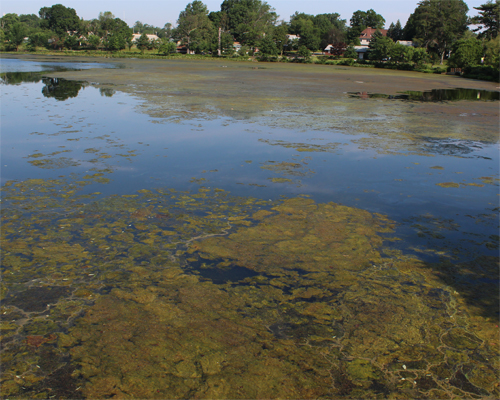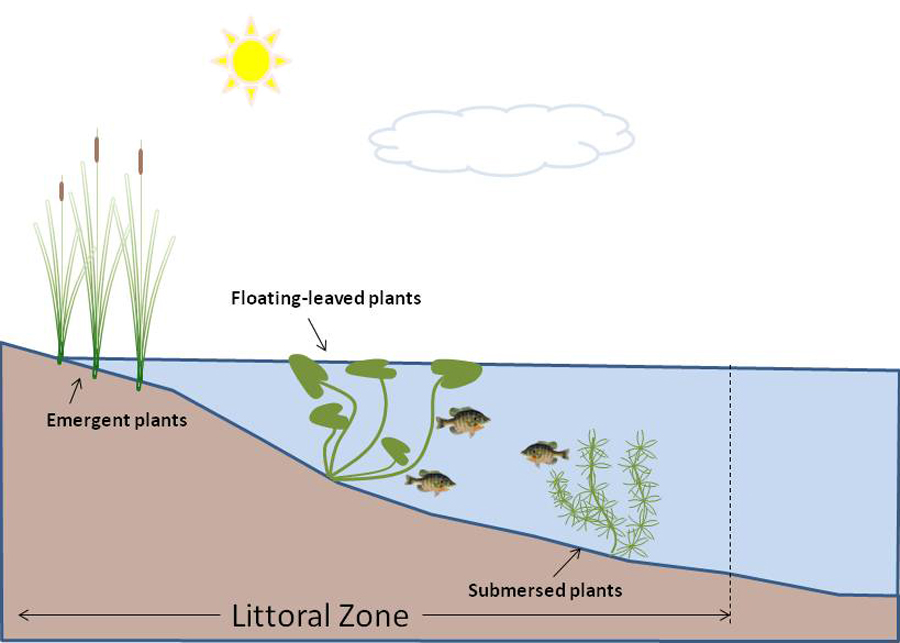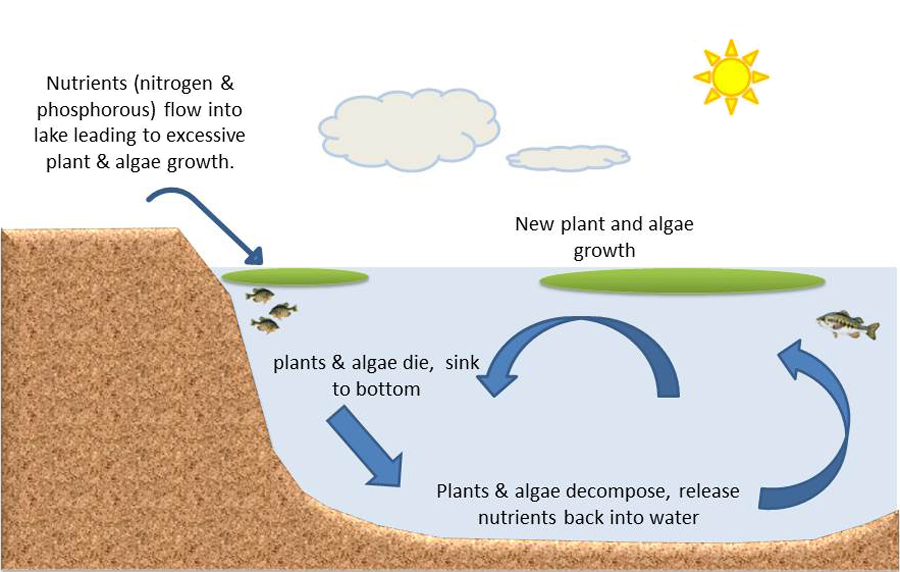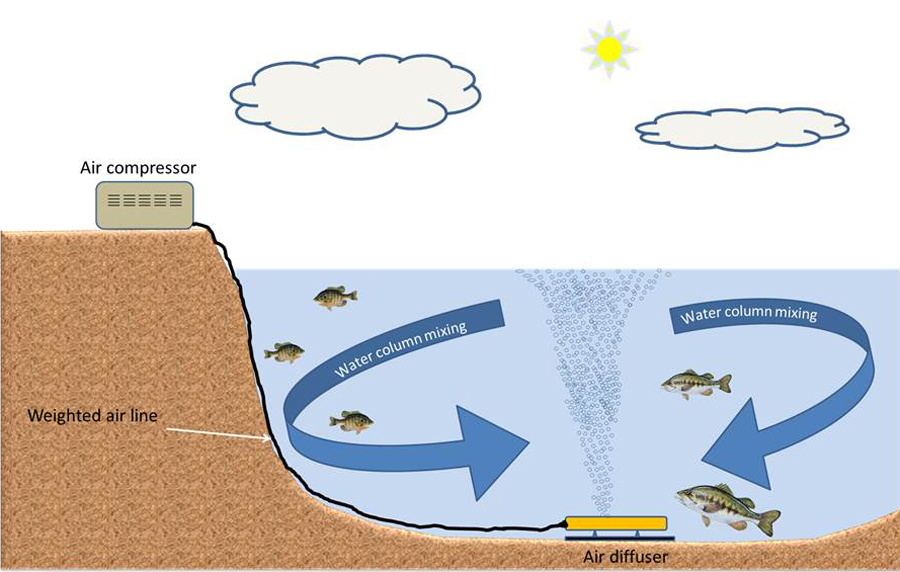
Fact Sheet FS1231
Description
Filamentous algae can be found worldwide in fresh water and marine environments. Numerous species of filamentous algae exist, all with similar growth and appearance, and often more than one species is present in a water body at the same time. Some of the more common forms can be distinguished by their texture. Spirogyra is bright green and slimy to the touch, Cladophora has a cotton-like feel, and Pithophora has a coarse texture similar to horse hair. They typically appear as a "mat" or mass usually green in color, but may become yellow, gray to brown, long, stringy hairlike strands. Individual filaments are a series of cells joined end to end for a threadlike appearance. These filaments entwine and can form mats resembling wet wool, cotton, or slime, starting in the early spring.
Habitat
Most filamentous algae prefer stagnant, nutrient rich, warm waters. Spirogyra however, is one species that flourishes more in cooler spring and fall months. They are found to dominate the littoral zone (the shallow, near-shore area where sunlight can penetrate to the bottom allowing aquatic plants to grow) (Fig.1) of lakes, ponds, and streams, and can also grow in wet places like ditches and moist surfaces. Growth is sometimes referred to as a "bloom" because the algae can grow quickly. Single cells reproduce into long strands that grow towards the water’s surface. As they grow, the algae produce oxygen during the day through photosynthesis. The algal strands trap the oxygen allowing the algae to float to the surface forming large dense mats. The cause of these algal accumulations is typically associated with an overabundance of nutrients—particularly nitrogen and phosphorous—in the water.

Figure 1: Lake and pond littoral zone.
Impacts to the Aquatic Ecosystem
Filamentous algae are an essential component of the aquatic ecosystem. They serve as a food source for protozoa and invertebrates, provide oxygen to the water and provide habitat for small animals including aquatic insects, fish, snails, and scud. However, problems arise when excess nutrients (nitrogen and phosphorous) causes excessive growth to reach nuisance levels resulting in an algal accumulation known as mats, moss, water net, frog spittle, or scum. Over abundant growth can interfere with recreational activity and degrade water quality. Excessive amounts can result in water quality management concerns. Concerns include low dissolved oxygen levels in the water (potentially leading to fish kills), becoming unsightly, or emitting an odor as algae decay. Filamentous algae are often a persistent problem because they reproduce rapidly by fragments, spores, and cell division. Various control strategies can be used to prevent or reduce problems associated with filamentous algae and should be part of an annual maintenance plan.
Prevention and Control
Preventing algal accumulations from occurring in the first place is preferred and less costly then controlling them after they have become a problem. The key to effective long-term control of algal blooms is limiting, reducing or redirecting, the input of external nutrients (primarily nitrogen and phosphorous) into waterways. Potential nutrient sources include runoff from maintained lawns and golf courses, fertilized fields, waste from barnyards, livestock, pets and wildlife, and poorly functioning septic systems. Reductions can be achieved by planting low maintenance lawns, testing your soil, applying less fertilizer near waterways, using phosphorous free fertilizer, maintaining vegetative buffer strips to absorb nutrients, increase bank stability to reduce soil erosion, and maintaining proper aeration and good water flow. Failure to address the nutrient problem will result in a perpetual need to control the over abundant filamentous algal growth using other control measures. Nutrients, particularly phosphorous, are recycled within a lake or pond (Fig. 2), so even after external inputs of nutrients have been reduced, it can still take many years for a waterway to recover. To determine the level of nutrients in your lake or pond, water samples should be collected and sent to a certified laboratory for analysis of nitrogen and phosphorous.
Mechanical, Biological, or Chemical Methods
Mechanical control involves removing large mats of filamentous algae using a rake or net. This labor intensive method can be effective, but provides short-term control and will need to be repeated multiple times during the peak growing season. This method will also remove nutrients from the water (in the form of algae biomass) but it is important to dispose of the algae away from the water’s edge to prevent nutrients from recycling back into the aquatic system as the algae decays. In some lakes and ponds, an underwater diffuser aeration system can be used to create an in-lake circulation that helps to oxygenate the bottom water layer (Fig. 3). Oxygenating the bottom water encourages phosphorous to stay bound with the bottom sediment, reducing its availability for algal growth. Although aeration is not totally effective in controlling growth, additional oxygen encourages a healthy microbial population that uses up nutrients that would otherwise be available to algae.

Figure 2: Lake and pond nutrient cycling.
Biological control involves disrupting algae growth by modifying the aquatic environment. Use of barley straw has been shown to have some success inhibiting filamentous algal growth. However, it does not kill the algae and straw must be applied in the winter or early spring to prevent growth. Grass carp are large non-native herbivorous fish that feed on aquatic plants. They are not recommended as a management strategy as the carp do not find filamentous algae palatable if other aquatic plants are available. In New Jersey, stocking of grass carp is strictly regulated and requires a permit from the New Jersey Department of Environmental Protection.
Chemical control of filamentous algae is situation- specific and several factors need to be considered:
- The algae must be properly identified. Most herbicides control only certain plant types as indicated on the product label.
- Consider the use of the waterway to be treated. Most herbicides restrict the use of the water until the herbicide has been degraded, inactivated, or dissipated.
- New Jersey Department of Environmental Protection administers the regulations regarding application of pesticide chemicals to waterways in New Jersey. Pesticide applications require a permit and can only be applied by a certified pesticide applicator.
- Calculation of water area/volume to be treated is necessary for proper dosage.
- A specific type of equipment may be needed for the application of a given chemical treatment to be effective; its availability may influence the product that is selected.
- Timing is important when deciding which herbicide to use. It is best to treat early in the season when algae are just beginning to grow and not firmly established. This will reduce the amount of algae needed to be killed and reduce the chance of fish kills due to low dissolved oxygen caused by decaying plants.
- Never treat the entire lake or pond at one time (see above).
- Water temperature affects the efficacy of some herbicides. Application should occur when algae are actively growing with a compatible temperature. Label recommendations should be followed.

Figure 3: Underwater air diffuser system to create circulation.
Some of the common aquatic herbicides used to control filamentous algae in waterways include the following trade names: Algae Pro, Copper Sulfate, Cutrine-Plus, Hydrothol 191, GreenClean, Reward, Weedtrine-D and Clipper. Most chemicals work to kill filamentous algae by disrupting the cell wall and inhibiting photosynthesis. Aquashade is a dye used to darken the water and reduce the amount of sunlight available for photosynthesis of aquatic plants, thereby limiting growth. Chemical treatments are effective, but often must be repeated annually or given multiple treatments per year to keep the algae under control. Cost should be considered. A combination of chemical and nonchemical control may provide the best results. A more detailed review of aquatic pesticide use can be found in Rutgers Cooperative Extension Fact Sheet FS386, "Aquatic Weed Control" (Hart, 2001).
References and Resources
Mention or display of a trademark, proprietary product, or firm in text or figures does not constitute an endorsement by Rutgers Cooperative Extension and does not imply approval to the exclusion of other suitable products or firms.
March 2014
Copyright © 2025 Rutgers, The State University of New Jersey. All rights reserved.
For more information: njaes.rutgers.edu.
Cooperating Agencies: Rutgers, The State University of New Jersey, U.S. Department of Agriculture, and Boards of County Commissioners. Rutgers Cooperative Extension, a unit of the Rutgers New Jersey Agricultural Experiment Station, is an equal opportunity program provider and employer.



